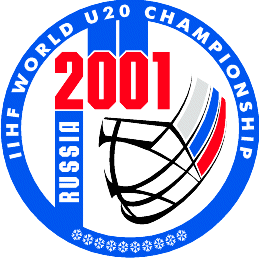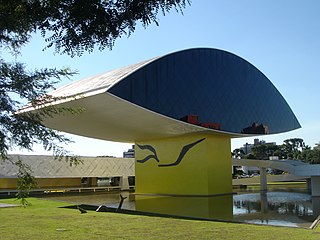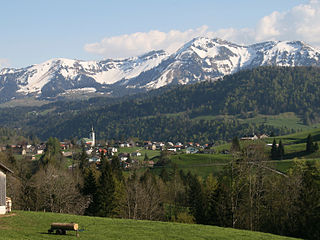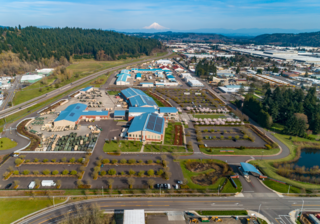
Vorarlberg is the westernmost state of Austria. It has the second-smallest geographical area after Vienna and, although it also has the second-smallest population, it is the state with the second-highest population density. Two thirds of the country are situated above 1,000m. It borders three countries: Germany, Switzerland, and Liechtenstein. The only Austrian state that shares a border with Vorarlberg is Tyrol, to the east.

The Bregenzerwald is one of the main regions in the state of Vorarlberg (Austria). It overlaps, but is not coterminous with, the Bregenz Forest Mountains, which belong to a range of the Northern Limestone Alps, specifically the northern flysch zone. It is the drainage basin of the Bregenzer Ach river.
Denton Corker Marshall is an international architecture practice based in Melbourne, Australia.

Light tubes are structures that transmit or distribute natural or artificial light for the purpose of illumination and are examples of optical waveguides.

The 2001 IIHF World U20 Championship, commonly referred to as the 2001 World Junior Hockey Championships, was the 25th edition of the Ice Hockey World Junior Championship. The tournament was held in Moscow and Podolsk, Russia from December 26, 2000, to January 5, 2001. The Czech Republic won the gold medal for the second consecutive year with a 2–1 victory over Finland in the championship game, while Canada won the bronze medal with a 2–1 overtime victory over Sweden.

The Oscar Niemeyer Museum is located in the city of Curitiba, in the state of Paraná, in Brazil. It was inaugurated in 2002 with the name Novo Museu or New Museum. With the conclusion of remodeling and the construction of a new annex, it was reinaugurated on July 8, 2003, with the current denomination to honor its famous architect who completed this project at 95 years of age, Oscar Niemeyer. It is also known as Museu do Olho or Eye Museum, due to the design of the main building.

Marco Mario Paolo Casagrande is a Finnish architect, environmental artist, architectural theorist, former mercenary, writer and professor of architecture. He graduated from Helsinki University of Technology department of architecture (2001). Casagrande has been identified as an anarchist architect.

Jonas Salk Hall at the University of Pittsburgh is a Pennsylvania state and Pittsburgh History and Landmarks Foundation Historic Landmark. The Art Deco building is named after Jonas Salk, who conducted his research on the first polio vaccine in a basement laboratory while on the faculty at the University of Pittsburgh.

Detroit–Shoreway is a neighborhood on the West Side of Cleveland, in the U.S. state of Ohio. Detroit–Shoreway consists of the streets between Lake Erie and Interstate 90, from West 85th to West 45th streets.

The Sámi Parliament of Norway is the representative body for people of Sámi heritage in Norway. It acts as an institution of cultural autonomy for the Sami people of Norway.

The American Police Hall of Fame & Museum is located at 6350 Horizon Drive just south of Titusville, Florida, adjacent to the Astronaut Hall of Fame. It houses law enforcement exhibits, a memorial and a Hall of Fame. It is the nation's first national police museum and a memorial dedicated to law enforcement officers killed in the line of duty.

Hittisau is a municipality in the district of Bregenz in the Austrian state of Vorarlberg. Hittisau has a surface area of 46.65 km2. It lies in the Bregenzerwald in the west of the country.

Alisa Harvey is a middle distance runner from the United States. She set her personal best in the women's 1,500 meters 4:08.32 on June 26, 1992, at the US Olympic Trials in New Orleans and in the 800 meters 1:59.72 in 1995. She was ranked in the U.S. top ten in the 1500 meters 8 years in a row from 1986 to 1993, achieving number 1 in 1993. After taking 1994 off for maternity, she returned to the list in 1998 and 1999. She also made the U.S. list in the 800 metres six times between 1988 and 1996. In 1998 she became the 24th American woman to break 4:30 for a mile. She is still an active masters competitor, holding several world records and pursuing more as she moves into a new age division.

The Bonn Women's Museum is a women's museum in Bonn, Germany. It was founded in 1981 by Marianne Pitzen and an interdisciplinary group of working women, and claims to be the first museum of its kind in the world. It hosts temporary exhibitions and accompanying events, and is run by the society "Women's Museum – Art, Culture, Research".

Battle command (BC) is the discipline of visualizing, describing, directing, and leading forces in operations against a hostile, thinking, and adaptive enemy. Battle command applies leadership to translate decision into actions, by synchronizing forces and warfighting functions in time, space, and purpose, to accomplish missions. Battle command refers both to processes triggered by commanders and executed by soldiers and to the system of systems (SoS) that directly enables those processes.
The Jiashi earthquakes were a series of earthquakes from 1997 to 2003, with several earthquakes larger than 6 occurring between January and April 1997. Two strong earthquakes with magnitudes Ms 6.4 and 6.3 occurred on January 21, 1997, at 09:47 and 09:48 local time, respectively, in Jiashi County of Xinjiang Autonomous Region, NW China. The earthquakes occurred on a major strike-slip fault beneath the Tarim Basin. The fault has no surface expression and prior to the earthquake was unknown. At least 12 people were killed and 40 injured in the earthquakes of January 21. Another earthquake on March 1, 1997, at 14:04 local time with magnitude Ms 6.0 killed another person. On April 6, 11 and 16, other four earthquakes with magnitudes Ms 6.3, 6.4, 6.6 and 6.3 killed 8 people. Several predictions were made in this earthquake series. Some of the predictions were not fulfilled, while some preceded the predicted earthquake from 2.5 hours to 4 days. The April 11 earthquake occurred 30 minutes after a prediction was made. Rebiya Kadeer wrote that her career was significantly affected by the earthquakes, which were "one of the worst natural disasters that had occurred in the Uyghur nation in recent memory." One hundred villages and one thousand homes were leveled. Kadeer organized donations and aid for the area.

Camp Withycombe, located in Clackamas County, Oregon, United States, was originally established as Camp Benson after Governor Frank W. Benson, but was later renamed Camp Withycombe during World War I for Governor James Withycombe.
Adams and Woodbridge was an American architectural firm in the mid-twentieth-century New York City, established in 1945 by Lewis Greenleaf Adams, AIA, and Frederick James Woodbridge, FAIA, and disestablished in 1974 after the latter's death. It was the successor to the firms Evans, Moore & Woodbridge, Malmfeldt, Adams & Prentice, Adams & Prentice, and Malmfeldt, Adams & Woodbridge



















